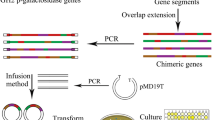Summary
Sodium lactobionate is not utilized as a carbon source byEscherichia coli because it is only poorly bound and hydrolyzed by β-galactosidase and it does not induce the formation of the enzyme. However, treatment with N-methyl-N′-nitro-N-nitrosoguanidine produced 32 independent mutants able to grow on lactobionate. Most of the mutants formed β-galactosidase constitutively, 29 of them having mutations in the regulatory gene and one possibly in the operator. In addition, the mutants possessed quantitatively—or qualitatively—altered β-galactosidase. In 28 mutants the β-galactosidase activity was 1.5 to 4.5 times that of the wild-type. The enzymes of these mutants were unaltered in thermostability and substrate binding. One enzyme that was titrated immunologically possessed a molecular activity indentical with the wild-type enzyme. These mutants appear to contain extra copies of the gene for β-galactosidase. The spontaneous mutation rate to constitutivity was 6.3x10-3 and to the formation of apparently extra genes, 9.2x10-3.
The β-galactosidases of three mutants were qualitatively changed as judged from their increased thermosensitivity, altered substrate-binding constants and greatly increased ability to hydrolyze lactose and lactobionate. Affinity for 0-nitrophenyl-β-galactoside and galactose was increased by the mutations while that for lactose was decreased; maximum velocities for the hydrolysis of 0-nitrophenyl-β-galactoside were also decreased. Relative to their rates of hydrolysis of 0-nitrophenyl-β-galactoside, these altered enzymes hydrolyzed lactose at 6 to 8 times, and lactobionate up to 23 times, the rate given by the normal enzyme. The mutations appear to increase the hydrophobic nature of the enzyme near the aglycon binding site and facilitate the hydrolysis of more hydrophilic galactosides. The lactobionic acid positive character could be transferred to other bacteria by sexual conjugation when the enzyme changes were qualitative, but not when they were quantitative.
Similar content being viewed by others
References
Bernaerts, M. J., and J. de Ley: The catabolism of lactose and lactobionate byCorynebacterium simplex. Antonie v. Leeuwenhoek,23, 334–344 (1957).
Bourgeois, S., M. Cohn, and L. E. Orgel: Suppression of and complementation among mutants of the regulatory gene of the lactose operon ofEscherichia coli. J. molec. Biol.14, 300–302 (1965).
Horiuchi, T., S. Horiuchi, and A. Novick: The genetic basis of hypersynthesis of β-galactosidase. Genetics48, 157–169 (1963).
—, J. Tomizawa, and A. Novick: Isolation and properties of bacteria capable of high rates of β-galactosidase synthesis. Biochim. biophys. Acta (Amst.)55, 152–163 (1962).
Jacob, F., and J. Monod: Genetic regulatory mechanisms in the synthesis of proteins. J. molec. Biol.3, 318–356 (1961).
—, A. Ullmann et J. Monod: Le promoteur, élément génétique nécessaire à la expression d'un opéron. C. R. Acad. Sci. (Paris)258, 3125–3128, (1964).
Kuby, S. A., and H. A. Lardy: Purification and kinetics of β-D-galactosidase fromEscherichia coli K-12. J. Amer. chem. Soc.75, 890–896 (1953).
Langridge, J.: Genetic evidence for the disposition of the substrate binding site of β-galactosidase. Proc. nat. Acad. Sci. (Wash.)60, 1260–1267 (1968a).
—: Genetic and enzymatic experiments relating to the tertiary structure of β-galactosidase. J. Bact.96, 1711–1717 (1968b).
—: Thermal responses of mutant enzymes and temperature limits to growth. Molec. Gen. Genetics103, 116–126 (1968c).
—, and J. Campbell: Classification and intragenic position of mutations inactivating the gene for β-galactosidase inEscherichia coli. Molec. Gen. Genetics103 339–347 (1968).
Levy, G. A., A. McAllan, and A. J. Hay: Inhibition of glycosidases by aldonolactones of corresponding configuration. 3. Inhibitors of β-D-galactosidase. Biochem. J.82, 225–232 (1962).
Magasanik, B.: Catabolite repression. Cold Spr. Harb. Symp. quant. Biol.26, 249–256 (1961).
Mandelstam, J.: The repression of constitutive β-galactosidase inEscherichia coli by glucose and other carbon sources. Biochem. J.82, 489–493 (1962).
Revel, H. R.: Synthesis of β-D-galactosidase after F-duction of lac+ genes intoEscherichia coli. J. molec. Biol.11, 23–34 (1965).
Wallenfels, K.: Transgalaktosylation. Bull. Soc. Chim. biol. (Paris)42, 1715–1735 (1960).
Willson, C., D. Perrin, M. Cohn, F. Jacob, and J. Monod: Non-inducible mutants of the regulator gene in the “lactose” system ofEscherichia coli. J. molec. Biol.8, 582–592 (1964).
Author information
Authors and Affiliations
Additional information
Communicated by R. Pritchard
Rights and permissions
About this article
Cite this article
Langridge, J. Mutations conferring quantitative and qualitative increases in β-galactosidase activity inEscherichia coli . Molec. Gen. Genet. 105, 74–83 (1969). https://doi.org/10.1007/BF00750315
Received:
Issue Date:
DOI: https://doi.org/10.1007/BF00750315




